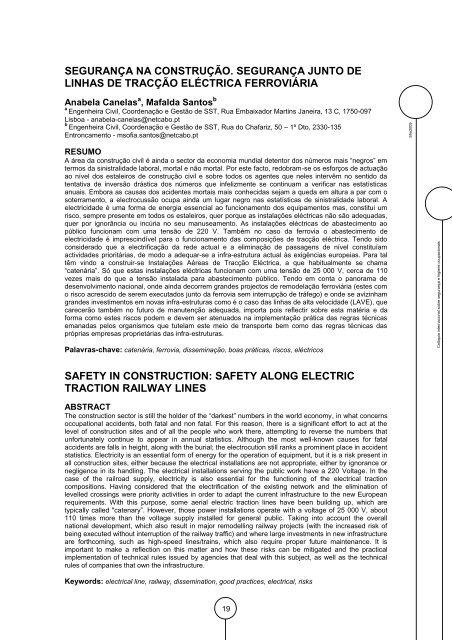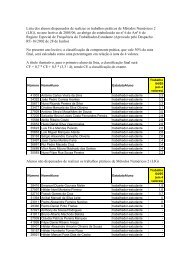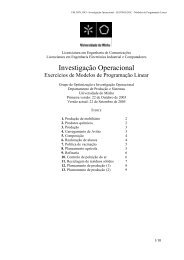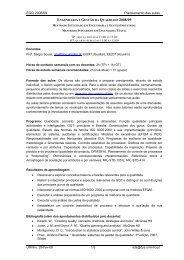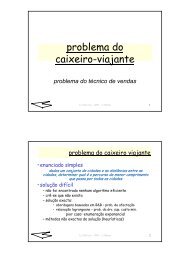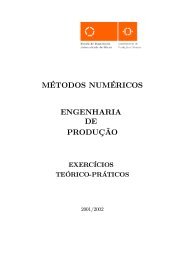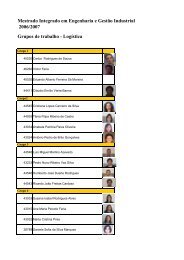miolo sho2009_indices v8 - Departamento de Produção e Sistemas ...
miolo sho2009_indices v8 - Departamento de Produção e Sistemas ...
miolo sho2009_indices v8 - Departamento de Produção e Sistemas ...
- No tags were found...
You also want an ePaper? Increase the reach of your titles
YUMPU automatically turns print PDFs into web optimized ePapers that Google loves.
Colóquio internacional sobre segurança e higiene ocupacionaisSho2009SEGURANÇA NA CONSTRUÇÃO. SEGURANÇA JUNTO DELINHAS DE TRACÇÃO ELÉCTRICA FERROVIÁRIAAnabela Canelas a , Mafalda Santos baEngenheira Civil, Coor<strong>de</strong>nação e Gestão <strong>de</strong> SST, Rua Embaixador Martins Janeira, 13 C, 1750-097Lisboa - anabela-canelas@netcabo.ptbEngenheira Civil, Coor<strong>de</strong>nação e Gestão <strong>de</strong> SST, Rua do Chafariz, 50 – 1º Dto, 2330-135Entroncamento - msofia.santos@netcabo.ptRESUMOA área da construção civil é ainda o sector da economia mundial <strong>de</strong>tentor dos números mais “negros” emtermos da sinistralida<strong>de</strong> laboral, mortal e não mortal. Por este facto, redobram-se os esforços <strong>de</strong> actuaçãoao nível dos estaleiros <strong>de</strong> construção civil e sobre todos os agentes que neles intervêm no sentido datentativa <strong>de</strong> inversão drástica dos números que infelizmente se continuam a verificar nas estatísticasanuais. Embora as causas dos aci<strong>de</strong>ntes mortais mais conhecidas sejam a queda em altura a par com osoterramento, a electrocussão ocupa ainda um lugar negro nas estatísticas <strong>de</strong> sinistralida<strong>de</strong> laboral. Aelectricida<strong>de</strong> é uma forma <strong>de</strong> energia essencial ao funcionamento dos equipamentos mas, constitui umrisco, sempre presente em todos os estaleiros, quer porque as instalações eléctricas não são a<strong>de</strong>quadas,quer por ignorância ou incúria no seu manuseamento. As instalações eléctricas <strong>de</strong> abastecimento aopúblico funcionam com uma tensão <strong>de</strong> 220 V. Também no caso da ferrovia o abastecimento <strong>de</strong>electricida<strong>de</strong> é imprescindível para o funcionamento das composições <strong>de</strong> tracção eléctrica. Tendo sidoconsi<strong>de</strong>rado que a electrificação da re<strong>de</strong> actual e a eliminação <strong>de</strong> passagens <strong>de</strong> nível constituíamactivida<strong>de</strong>s prioritárias, <strong>de</strong> modo a a<strong>de</strong>quar-se a infra-estrutura actual às exigências europeias. Para taltêm vindo a construir-se Instalações Aéreas <strong>de</strong> Tracção Eléctrica, a que habitualmente se chama“catenária”. Só que estas instalações eléctricas funcionam com uma tensão <strong>de</strong> 25 000 V, cerca <strong>de</strong> 110vezes mais do que a tensão instalada para abastecimento público. Tendo em conta o panorama <strong>de</strong><strong>de</strong>senvolvimento nacional, on<strong>de</strong> ainda <strong>de</strong>correm gran<strong>de</strong>s projectos <strong>de</strong> remo<strong>de</strong>lação ferroviária (estes como risco acrescido <strong>de</strong> serem executados junto da ferrovia sem interrupção <strong>de</strong> tráfego) e on<strong>de</strong> se avizinhamgran<strong>de</strong>s investimentos em novas infra-estruturas como é o caso das linhas <strong>de</strong> alta velocida<strong>de</strong> (LAVE), quecarecerão também no futuro <strong>de</strong> manutenção a<strong>de</strong>quada, importa pois reflectir sobre esta matéria e daforma como estes riscos po<strong>de</strong>m e <strong>de</strong>vem ser atenuados na implementação prática das regras técnicasemanadas pelos organismos que tutelam este meio <strong>de</strong> transporte bem como das regras técnicas daspróprias empresas proprietárias das infra-estruturas.Palavras-chave: catenária, ferrovia, disseminação, boas práticas, riscos, eléctricosSAFETY IN CONSTRUCTION: SAFETY ALONG ELECTRICTRACTION RAILWAY LINESABSTRACTThe construction sector is still the hol<strong>de</strong>r of the “darkest” numbers in the world economy, in what concernsoccupational acci<strong>de</strong>nts, both fatal and non fatal. For this reason, there is a significant effort to act at thelevel of construction sites and of all the people who work there, attempting to reverse the numbers thatunfortunately continue to appear in annual statistics. Although the most well-known causes for fatalacci<strong>de</strong>nts are falls in height, along with the burial; the electrocution still ranks a prominent place in acci<strong>de</strong>ntstatistics. Electricity is an essential form of energy for the operation of equipment, but it is a risk present inall construction sites, either because the electrical installations are not appropriate, either by ignorance ornegligence in its handling. The electrical installations serving the public work have a 220 Voltage. In thecase of the railroad supply, electricity is also essential for the functioning of the electrical tractioncompositions. Having consi<strong>de</strong>red that the electrification of the existing network and the elimination oflevelled crossings were priority activities in or<strong>de</strong>r to adapt the current infrastructure to the new Europeanrequirements. With this purpose, some aerial electric traction lines have been building up, which aretypically called "catenary”. However, those power installations operate with a voltage of 25 000 V, about110 times more than the voltage supply installed for general public. Taking into account the overallnational <strong>de</strong>velopment, which also result in major remo<strong>de</strong>lling railway projects (with the increased risk ofbeing executed without interruption of the railway traffic) and where large investments in new infrastructureare forthcoming, such as high-speed lines/trains, which also require proper future maintenance. It isimportant to make a reflection on this matter and how these risks can be mitigated and the practicalimplementation of technical rules issued by agencies that <strong>de</strong>al with this subject, as well as the technicalrules of companies that own the infrastructure.Keywords: electrical line, railway, dissemination, good practices, electrical, risks19


